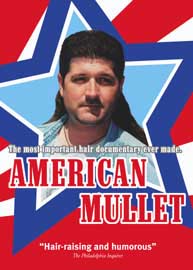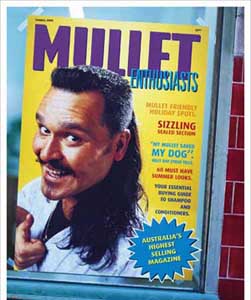-
- In historic ruling, Supreme Court strikes down Texas’ ban on gay sex
- Notable dates in GLBT history
- Senate leader endorses federal gay marriage ban
- ACLU sues over gays’ exclusion from parade
- N.J. court hears arguments in same-sex marriage case
- Delaware House approves GLBT legislation
- National News Briefs
- World News Briefs
Arts & Entertainment
Short in the front, long in the back
Documentary unmasks the mullet haircut craze
Published Thursday, 03-Jul-2003 in issue 810
Known as the bi-level, the mudflap, hockey hair, business in the front, party in the back, the sh’long and worse, the mullet is an odd phenomenon. Commonly associated with lesbians and rednecks, this popular hairdo has been the butt of many jokes and an enduring source of dazed incomprehension and occasional outright hostility from those who wonder why anyone would wear their hair short in front and long in back.
So who willingly wears a mullet, and, perhaps more importantly, why?
With the release of American Mullet, Palm Pictures has answered these questions and more. Director Jennifer Arnold and interviewer Mathew Bose set off on a cross-country expedition, taking an in-depth look at the mullet and its cultural significance. Contrary to what you might expect, the film’s pretty entertaining — and not in a condescending fashion. Quirky, yes, but fascinating.
American Mullet talks with mullet-sporting soccer and hockey jocks, Mexican macho men, bikers, butch babes, traditional Native Americans, country music devotees and others in the effort to discover the basis for this puzzling cultural marvel, and finds as many reasons for the passionate devotion to the mullet as there are variations on the hairstyle.
It’s not likely to convince you to rush right out and start wearing a mullet yourself, but it may well inspire a little more respect for those who do. Yes, mullet wearers are generally aware that their chosen hairstyle makes them an object of scorn to many. And no, they don’t particularly seem to care. Although there is one interviewee — a Billy Ray Cyrus impersonator — who refers to his hairstyle as a “babe magnet,” and maybe for him it is. It’s probably safe to assume that anyone who likes Billy Ray Cyrus enough to follow an impersonator around will like this hairstyle.
A biker with tattoos aplenty and a sticker on his helmet that reads, “A woman’s place is on my face” points out that, “A lot of personal appearance choices are an extension of one’s personality. A lot of them are a flag to other people, saying, ‘Hey, this is me. This is who I am. Love it, don’t love it.…’ It’s definitely a statement.” But sometimes people misread the statement. It turns out that, although many people assume he never made it past the eighth grade, this interviewee is college-educated and has a very conservative appearing wife and adoring daughter.
And then there’s Sam, who is basically what he appears to be — an ’80s metal fan. “I like my hairstyle because I think the whole ’80s culture was about having fun,” he says. “At least back then those people had a positive message. The message was getting out and getting laid — hey, that works for me. They certainly aren’t saying that now.… I won’t change my hairstyle because it’s me. It’s a symbol of where I come from and I’m not ashamed of it.”
There is a fascinating, but rather painful, segment in which two lesbian scholars give a presentation on the place of the mullet in lesbian style. Their commentary is arch and provokes a great deal of laughter from the audience — with the notable exception of the one mullet-wearing woman.
“Some of the comments I heard were ‘bad haircut, out of date,’ and probably some other not so flattering comments,” she tells the interviewer. “The reason I let my hair grow was because I was getting very tired of being called sir.… And as I’ve gotten older, I’ve become more comfortable with letting more of a feminine side show.”
Her discomfort is palpable, and suddenly the laughter of the audience simply seems cruel.
Another lesbian interviewee gives a very thoughtful dissertation on why people feel so free to mock the mullet and sometimes react violently to it. “It’s not really kosher anymore to poke fun at somebody’s sexuality or class status,” she says, “so you poke fun at something that maybe symbolizes that.” Her theory is that the mullet is a genderless hairstyle and that, in crossing gender lines, it taps into a very fundamental fear. “I think a lot of homophobia in this country is not about sexuality,” she adds, “it’s about gender.”
The American Mullet DVD includes added bonus segments. You can learn the basics of making a do-it-yourself recumbent motorscooter with cardboard and tape. And, of course, no documentary on the mullet would be complete without a professional demonstration of advanced mullet cutting technique.
The whole point of a documentary is to explore a topic in depth, to show different perspectives in a way that makes them understandable, as well as intriguing. American Mullet does this well. Whether you love the mullet, hate the mullet or don’t particularly give a damn about it, American Mullet is worth a look.
American Mullet is produced by Tom Gorai, Dorka Keehn and Allison Hebble, and is available at select bookstores or via the Internet.
|
|
Copyright © 2003-2025 Uptown Publications



